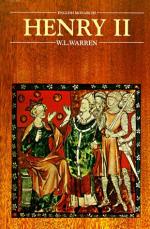Meanwhile in England the rebellion had broken out in July. The Scottish army ravaged the north; the Earl of Leicester, with an army of Flemings which he had collected by the help of Louis and the younger Henry, landed on the coast of Suffolk, where Hugh Bigod was ready to welcome him. De Lucy and Bohun hurried from the north to meet this formidable danger, and with the help of the Earls of Cornwall, Arundel, and Gloucester, they defeated Leicester in a great battle at Fornham on the 17th of October. The earl himself was taken prisoner, and 10,000 of his foreign troops were slain. He and his wife were sent by Henry’s orders to Normandy, and there thrown into prison. A truce was made with Scotland till the end of March. The king of France and the younger Henry abandoned hope, “for they saw that God was with the king;” and there was a general pause in the war.
With the spring of 1174, however, the strife raged again on all sides. Ireland rose in rebellion. William of Scotland marched into England supported by a Flemish force. Roger Mowbray, and probably the Bishop of Durham, were in league with him. Earl Ferrers fortified his castles in Derby and Stafford; Leicester Castle was still held by the Earl of Leicester’s knights; Huntingdon by the Scot king’s brother; and the Earl of Norfolk was joined in June by a picked body of Flemings. The king’s castles at Norwich, Northampton, and Nottingham, were taken by the rebels, and a formidable line of enemies stretched right across mid-England. At the same time France and Flanders threatened invasion with a strong fleet, and “so great an army as had not been seen for many years.” Count Philip, who had set his heart on the promised Kent, and on winning entrance into the lands of the Cistercian wool-growers of Lincolnshire, swore before Louis and his nobles that within fifteen days he would attack England; the younger Henry joined him at Gravelines in June, and they only waited for a fair wind to cross the Channel.




